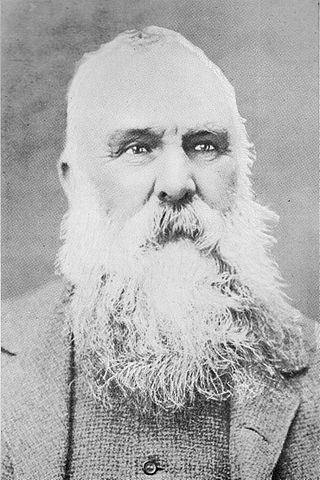
Dolgellau is a town and community in Gwynedd, north-west Wales, lying on the River Wnion, a tributary of the River Mawddach. It was the traditional county town of the historic county of Merionethshire until the county of Gwynedd was created in 1974. Dolgellau is the main base for climbers of Cadair Idris and Mynydd Moel which are visible from the town. Dolgellau is the second largest settlement in southern Gwynedd after Tywyn and includes the community of Penmaenpool.
The Presbyterian Church of Wales, also known as the Calvinistic Methodist Church, is a denomination of Protestant Christianity based in Wales.

Michael Daniel Jones was a Welsh Congregationalist minister and principal of a theological college, but is best remembered as a founder of the Welsh settlement in Patagonia known as Y Wladfa and as one of the fathers of modern Welsh nationalism.

Sir Owen Morgan Edwards was a Welsh historian, educationalist and writer. He is often known as O. M. Edwards.

Llanuwchllyn is a village and community in Gwynedd, Wales, near the southern end of Bala Lake. It is one of the most sparsely populated communities in Wales.

William Williams of Wern was an Independent minister in Wales, and the promoter of the "General Union" movement of 1834. He was one of three "giants of the Welsh pulpit", along with John Elias and Christmas Evans.

William Owen Pughe was a Welsh antiquarian and grammarian best known for his Welsh and English Dictionary, published in 1803, but also known for his grammar books and "Pughisms" (neologisms).

Sir Ifan ab Owen Edwards was a Welsh academic, writer and film-maker, best known as the founder of Urdd Gobaith Cymru, the Welsh League of Youth.
This article is about the particular significance of the year 1788 to Wales and its people.

Henry Parry was a Welsh clergyman and antiquarian.

Anwyl of Tywyn are a Welsh family who claim a patrilinear descent from Owain Gwynedd, King of Gwynedd from 1137 to 1170 and a scion of the royal House of Aberffraw. The family motto is: Eryr eryrod Eryri, which translates as "The Eagle of the Eagles of Snowdonia. The family lives in Gwynedd and speak Welsh.

Richard Llwyd, also known as The Bard of Snowdon, was a Welsh author, poet and expert on Welsh heraldry and genealogy. His most notable work is the poem Beaumaris Bay, which was published in 1800.
Ifor Owen was a Welsh educator who was notable for writing, illustrating and publishing Hwyl, the first children's comic book in the Welsh language.

Rev. Elias Owen MA, F.S.A. was a Welsh cleric and antiquarian whose works include The Old Stone Crosses of the Vale of Clwyd, 1886 and Welsh Folk-Lore, 1896.
Sir David Hughes Parry was a university administrator, Professor of Law and Vice-Chancellor of the University of London from 1945 to 1948. He was also founder of the university's Institute of Advanced Legal Studies in 1947.

Robert Thomas, also known by the bardic name Ap Vychan, was a Welsh Independent minister, poet and man of letters. He won the chair at the national eisteddfod on two occasions.
Edward Davies was an American minister, author, and publisher of the Welsh Congregational magazine, the Cenhadwr. He was a pastor of Congregational, Peniel, and Bethel churches in the state of New York.

Ellis Thomas Davies was a Welsh Independent minister. He was born at Tymawr, Penant Lliw Bach, and grew up in the Llanuwchllyn area, where his father was an elder in the ‘Old Chapel'. He attended school at Weirglodd Wen, tutored by the local minister, Michael Jones. He then continued his education at Brecon College. He had begun to preach in 1842, and in 1847 began to minister to the churches at Llansantsiôr and Moelfre. After being ordained the following year, he was appointed to the church at Abergele, where he remained for the rest of his ministry, retiring in 1887. He died in 1895.
John Davies, also known by his bardic name of Siôn Dafydd Las, was a Welsh bard active in the late 17th century. He is thought to have been from the Llanuwchllyn area of North Wales, and he may have lived in the Tyn-y-ffridd area for a while.

John Griffith was a Welsh journalist based in London. He was known by his pen name "Y Gohebydd".












